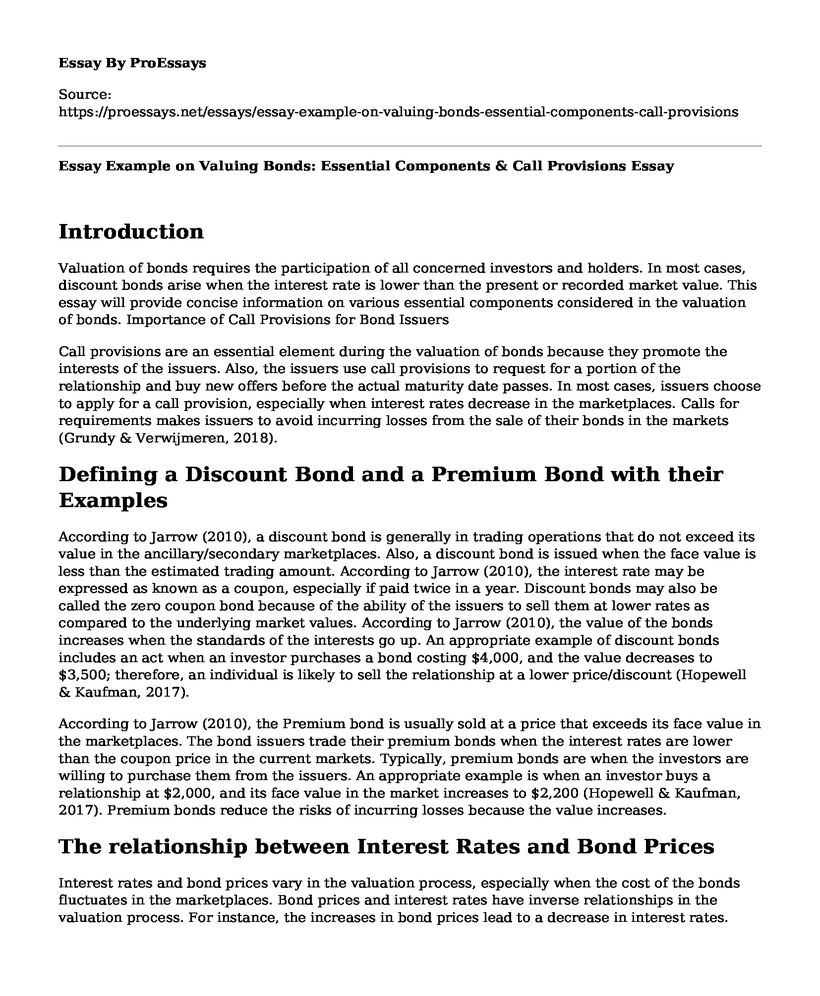Introduction
Valuation of bonds requires the participation of all concerned investors and holders. In most cases, discount bonds arise when the interest rate is lower than the present or recorded market value. This essay will provide concise information on various essential components considered in the valuation of bonds. Importance of Call Provisions for Bond Issuers
Call provisions are an essential element during the valuation of bonds because they promote the interests of the issuers. Also, the issuers use call provisions to request for a portion of the relationship and buy new offers before the actual maturity date passes. In most cases, issuers choose to apply for a call provision, especially when interest rates decrease in the marketplaces. Calls for requirements makes issuers to avoid incurring losses from the sale of their bonds in the markets (Grundy & Verwijmeren, 2018).
Defining a Discount Bond and a Premium Bond with their Examples
According to Jarrow (2010), a discount bond is generally in trading operations that do not exceed its value in the ancillary/secondary marketplaces. Also, a discount bond is issued when the face value is less than the estimated trading amount. According to Jarrow (2010), the interest rate may be expressed as known as a coupon, especially if paid twice in a year. Discount bonds may also be called the zero coupon bond because of the ability of the issuers to sell them at lower rates as compared to the underlying market values. According to Jarrow (2010), the value of the bonds increases when the standards of the interests go up. An appropriate example of discount bonds includes an act when an investor purchases a bond costing $4,000, and the value decreases to $3,500; therefore, an individual is likely to sell the relationship at a lower price/discount (Hopewell & Kaufman, 2017).
According to Jarrow (2010), the Premium bond is usually sold at a price that exceeds its face value in the marketplaces. The bond issuers trade their premium bonds when the interest rates are lower than the coupon price in the current markets. Typically, premium bonds are when the investors are willing to purchase them from the issuers. An appropriate example is when an investor buys a relationship at $2,000, and its face value in the market increases to $2,200 (Hopewell & Kaufman, 2017). Premium bonds reduce the risks of incurring losses because the value increases.
The relationship between Interest Rates and Bond Prices
Interest rates and bond prices vary in the valuation process, especially when the cost of the bonds fluctuates in the marketplaces. Bond prices and interest rates have inverse relationships in the valuation process. For instance, the increases in bond prices lead to a decrease in interest rates. Also, bond prices decrease when the interest rates go up.
The Differences between a Coupon bond and a Zero Coupon Bond
The disparities between a coupon bond and a zero coupon depend on the number of profits gained after their sell (Hopewell & Kaufman, 2017). In a zero-coupon bond, profit increased results from variances in face values and the purchase prices. On the other hand, the common coupon bond receives the benefit after the distribution of trading interest. Also, the holder/issuer of a zero coupon bond gets the original bond value after the maturity date. On the other hand, the owner of the regular coupon bond gains the actual value during maturity and also throughout the lifespan.
Conclusion
In conclusion, bond valuation involves various activities like the determination of the market value of the assets. Appropriate analysis of the market forces ensure the active exchange of bonds and avoid the risks of incurring losses. Most investors prefer premium bonds over the discount ones.
References
Grundy, B. D., & Verwijmeren, P. (2018). The Buyers' Perspective on Security Design: Hedge Funds and Convertible Bond Call Provisions. Journal of Financial Economics, 127(1), 77-93. Retrieved from: https://www.sciencedirect.com/science/article/abs/pii/S0304405X1730291X
Hopewell, M. H., & Kaufman, G. G. (2017). Bond Price Volatility and Term to Maturity: A Generalized Specification. In Bond Duration and Immunization (pp. 64-68). Routledge. Retrieved from: https://www.taylorfrancis.com/books/e/9781315145976/chapters/10.4324/9781315145976-5
Jarrow, R. A. (2010). A Simple, Robust Model for CAT Bond Valuation. Finance Research Letters, 7(2), 72-79. Retrieved from: https://www.sciencedirect.com/science/article/abs/pii/S154461231000019X
Cite this page
Essay Example on Valuing Bonds: Essential Components & Call Provisions. (2023, Feb 23). Retrieved from https://proessays.net/essays/essay-example-on-valuing-bonds-essential-components-call-provisions
If you are the original author of this essay and no longer wish to have it published on the ProEssays website, please click below to request its removal:
- McDonalds Financial Analysis Paper
- Measuring Social, Environmental, and Economic Impacts on Business
- Paper Example on Baring Bank Risk Management
- General Industry Insurance Overview - Article Analysis Essay
- Investing in Real Estate: Key Considerations for Maximum ROI - Essay Sample
- Essay Example on Capital Budgeting: Making Decisions That Spur Growth and Add Value
- Investment Activities: Safety, Returns & Risk of Loss - Research Paper







